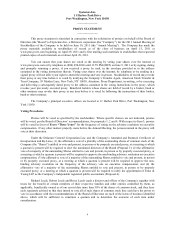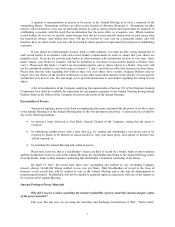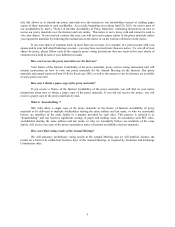CompUSA 2010 Annual Report Download - page 18
Download and view the complete annual report
Please find page 18 of the 2010 CompUSA annual report below. You can navigate through the pages in the report by either clicking on the pages listed below, or by using the keyword search tool below to find specific information within the annual report.15
compensation of the Chief Executive Officer and, after an evaluation of the Chief Executive Officer’ s performance
in light of such goals, to set the compensation of the Chief Executive Officer. The Compensation Committee also
approves (a) the annual compensation of the other executive officers of the Company, (b) the annual compensation
of certain subsidiary managers, and (c) all individual stock-based incentive grants. The Committee is also
responsible for reviewing and making periodic recommendations to the Board with respect to the general
compensation, benefits and perquisite policies and practices of the Company including the Company’ s incentive-
based and equity-based compensation plans. The Compensation Committee also prepares an annual report on
executive compensation for inclusion in the annual proxy statement. (See “Compensation Committee Report to
Stockholders” below.) The current members of the Compensation Committee are Robert D. Rosenthal (Chairman),
Stacy S. Dick and Marie Adler-Kravecas.
In addition, it is the Compensation Committee’ s responsibility to consider, and work together with the
Company’ s Audit Committee regarding, the Company’ s compensation policies for all its employees in the context
of how such policies affect and promote the Company’ s risk management goals and objectives.
The Compensation Committee Charter was last amended in April 2010. The Compensation Committee
Charter is available on the Company’ s website (www.systemax.com).
Executive Committee
The Executive Committee consists of the Chairman of the Board and any Vice Chairman and such other
Directors as may be named thereto by the Board. The current members of the Executive Committee are Messrs.
Richard Leeds, Robert Leeds, Bruce Leeds and Robert D. Rosenthal, the Lead Independent Director. Among other
duties as may be assigned by the Board from time to time, the Executive Committee is authorized to oversee the
operations of the Company, supervise the executive officers of the Company, review and make recommendations to
the Board regarding the strategic direction of the Company and review and make recommendations to the Board
regarding all possible acquisitions or other significant business transactions. The Executive Committee is also
authorized to manage the affairs of the Corporation between meetings of the Board; the Committee has all of the
powers of the Board not inconsistent with any provisions of the Delaware General Corporation Law, the Company’ s
Certificate of Incorporation or By-Laws or other resolutions adopted by the Board, but does not generally exercise
such authority.
Board Leadership Structure
As noted above, our Board currently includes three independent Directors. Richard Leeds has served as
Chairman and Chief Executive Officer since April 1995. Since May 2006 (in connection with adopting various
corporate governance enhancements) our independent directors have designated one of the independent directors as
Lead Independent Director. We believe that the current mix of employee directors and non-employee independent
directors that make up our Board, along with the independent oversight of our Lead Independent Director, benefits
the Company and its stockholders.
Although the Board does not have an express policy on whether or not the roles of Chief Executive Officer
and Chairman of the Board should be separate and if they are to be separate, whether the Chairman of the Board
should be selected from the non-employee Directors or be an employee, the Board believes that it should have the
flexibility to make a determination from time to time in a manner that is in the best interests of the Company and its
stockholders at the time of such determination. At this time, the Board of Directors believes that Mr. Leeds’ s
service as both Chairman of the Board and CEO is in the best interest of the Company and its stockholders. Mr.
Leeds possesses in-depth knowledge of the issues, opportunities and challenges facing the Company and its
businesses and is thus best positioned to develop agendas that ensure that the Board’ s time and attention are focused
on the matters that are most critical to the Company and its stockholders. His combined role has produced decisive
leadership, ensures clear accountability, and enhances the Company’ s ability to communicate its message and
strategy clearly and consistently to the Company’ s stockholders, employees, customers and suppliers, particularly
during times of turbulent economic conditions.
The Board believes that the independent directors provide effective oversight of management. Moreover, in
addition to feedback provided during the course of Board meetings, the independent directors have regular executive
























